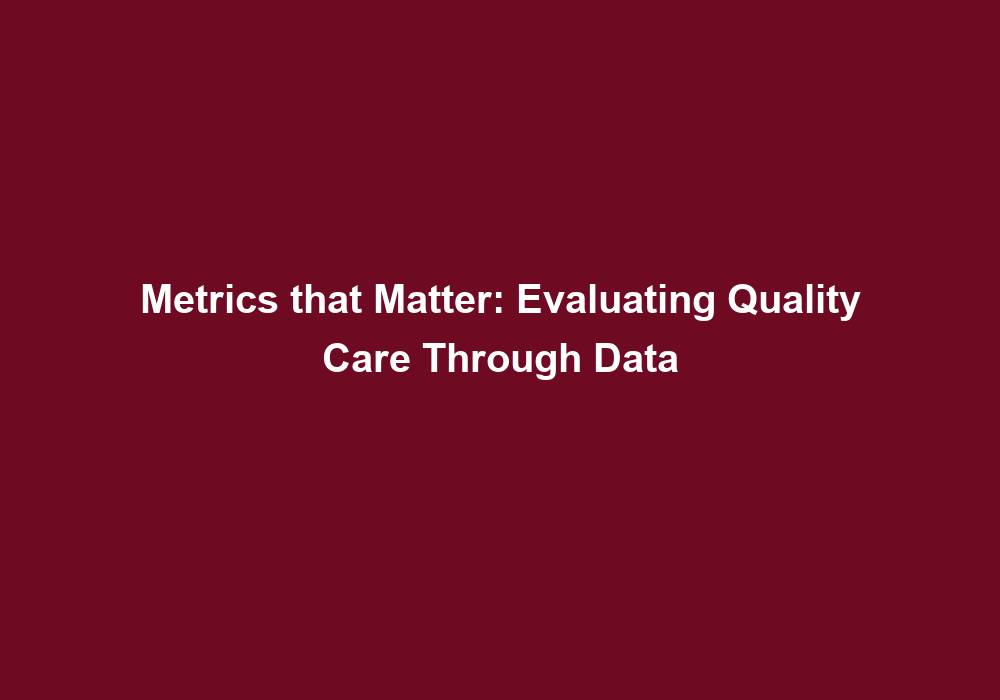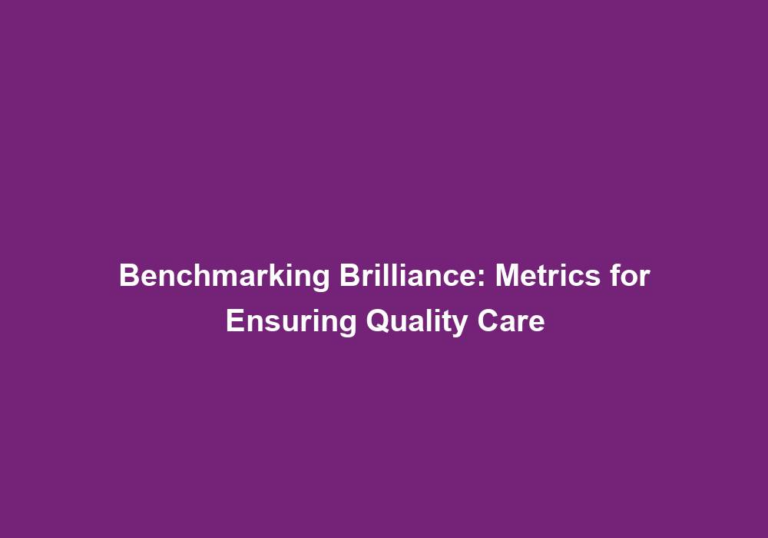Metrics that Matter: Evaluating Quality Care Through Data
In the healthcare industry, evaluating the quality of care provided is crucial for both patients and healthcare providers. To measure and assess the effectiveness of care, various metrics and data points play a significant role. These metrics help in identifying areas of improvement, benchmarking performance, and ensuring that patients receive the best possible care.
Why Metrics Matter in Evaluating Quality Care
Metrics are essential in evaluating quality care as they provide objective data that can be analyzed and compared over time. By tracking these metrics, healthcare providers can identify trends, assess the impact of interventions, and make data-driven decisions to improve patient outcomes.
Metrics also help in benchmarking performance. By comparing their metrics with industry standards or best practices, healthcare organizations can identify areas where they excel or lag behind. This allows them to learn from successful practices and implement changes to improve the quality of care.
Objective Data for Analysis and Comparison
Metrics provide objective data that can be collected and analyzed to evaluate the quality of care. By utilizing standardized measurement tools and data collection methods, healthcare providers can obtain accurate and reliable data. This data can then be compared over time to identify trends and patterns, allowing healthcare organizations to assess the effectiveness of their care delivery.
Data-Driven Decision Making
By relying on metrics, healthcare providers can make informed decisions based on objective data. This helps in prioritizing areas for improvement, allocating resources effectively, and implementing evidence-based practices. Data-driven decision making ensures that healthcare organizations are proactive in addressing issues and continuously improving the quality of care provided.
Benchmarking and Learning from Best Practices
Metrics allow healthcare organizations to benchmark their performance against industry standards or best practices. By comparing their metrics with those of high-performing organizations, healthcare providers can identify areas of improvement and adopt successful strategies. Benchmarking helps in setting realistic goals and continuously raising the bar for quality care.
Key Metrics for Evaluating Quality Care
- Patient Satisfaction Scores: Patient satisfaction is a crucial metric that reflects the overall experience patients have with healthcare services. It can be measured through surveys, feedback forms, or online reviews. A high patient satisfaction score indicates that patients are satisfied with the care they received and can be an indicator of quality care.
- Regularly collect patient feedback through surveys and feedback forms to measure satisfaction levels.
- Analyze the feedback to identify areas where improvements can be made, such as communication, care coordination, or staff responsiveness.
- Implement strategies to address the identified areas for improvement, ensuring that patient satisfaction remains high.
- Readmission Rates: Readmission rates measure the number of patients who are readmitted to the hospital within a certain period after discharge. High readmission rates may indicate gaps in care, inadequate discharge planning, or insufficient follow-up. By monitoring readmission rates, healthcare providers can identify areas where improvements are needed to reduce unnecessary readmissions.
- Analyze readmission rates to identify specific reasons for readmissions, such as medication errors, complications, or inadequate post-discharge care.
- Develop strategies to address the identified causes, such as patient education, improved care transitions, or enhanced post-discharge follow-up.
- Regularly monitor readmission rates to assess the effectiveness of interventions and make adjustments as needed.
- Length of Stay: Length of stay measures the average number of days a patient spends in the hospital. A shorter length of stay can indicate efficient care delivery and effective treatment plans. By reducing the length of stay without compromising patient outcomes, healthcare providers can optimize resource utilization and improve overall quality of care.
- Identify factors contributing to longer lengths of stay, such as delayed diagnostic tests, inefficient care processes, or lack of care coordination.
- Implement strategies to streamline care delivery and reduce unnecessary delays, such as improving care team communication, implementing care pathways, or enhancing discharge planning.
- Regularly track length of stay to evaluate the impact of interventions and make further improvements.
- Mortality Rates: Mortality rates measure the number of deaths per a specific population or time period. While not all deaths are preventable, high mortality rates may indicate systemic issues, suboptimal care, or inadequate patient monitoring. Monitoring mortality rates helps healthcare providers identify opportunities for improvement and implement strategies to reduce avoidable deaths.
- Analyze mortality rates to identify potential areas for improvement, such as specific diagnoses or procedures with higher mortality rates.
- Implement evidence-based practices and protocols to enhance patient monitoring, early detection of complications, and timely interventions.
- Regularly review mortality rates and assess the impact of implemented strategies to ensure continuous improvement in patient outcomes.
- Patient Safety Indicators: Patient safety indicators (PSIs) measure the occurrence of adverse events or complications during hospitalization. These indicators include hospital-acquired infections, pressure ulcers, falls, and medication errors, among others. By tracking PSIs, healthcare providers can identify areas where patient safety can be improved and implement preventive measures.
- Regularly monitor and report PSIs to identify specific areas of concern, such as high rates of hospital-acquired infections or medication errors.
- Develop and implement protocols and practices to reduce the occurrence of PSIs, such as hand hygiene programs, fall prevention strategies, or medication safety initiatives.
- Collaborate with multidisciplinary teams to create a culture of safety and continuously improve patient safety indicators.
- Healthcare-Associated Infections (HAIs): HAIs are infections that patients acquire during their healthcare journey. These infections can lead to prolonged hospital stays, increased healthcare costs, and even mortality. By monitoring and reducing HAIs, healthcare providers can ensure a safer environment for patients and improve overall quality of care.
- Implement robust infection prevention and control measures, such as hand hygiene protocols, proper disinfection practices, and surveillance systems.
- Educate healthcare staff on infection prevention practices and provide ongoing training to ensure compliance.
- Regularly monitor and report HAI rates to identify areas for improvement and assess the effectiveness of implemented measures.
- Clinical Outcome Measures: Clinical outcome measures evaluate the effectiveness of treatments and interventions. These measures assess specific health outcomes, such as improvement in pain levels, reduction in blood pressure, or improved mobility. By tracking clinical outcome measures, healthcare providers can evaluate the impact of their interventions and adjust treatment plans accordingly.
- Select appropriate clinical outcome measures based on the specific conditions or treatments being evaluated.
- Regularly collect and analyze data related to clinical outcome measures to assess the effectiveness of interventions.
- Use the findings to adjust treatment plans, implement evidence-based practices, and continuously improve patient outcomes.
Data Collection and Analysis
To effectively evaluate quality care through metrics, healthcare providers need to collect and analyze relevant data. This requires implementing robust data management systems and processes. Here are some key steps involved in data collection and analysis:
- Identify Relevant Data: Determine the metrics and data points that are most relevant to measure and evaluate quality care. This can be based on industry standards, best practices, or specific organizational goals.
- Conduct a comprehensive review of existing metrics and data sources to identify gaps and areas for improvement.
- Engage stakeholders, including healthcare professionals and patients, to determine which metrics are most meaningful and actionable.
- Prioritize the collection of data that aligns with organizational goals and can drive meaningful improvements in quality care.
- Implement Data Collection Methods: Develop standardized procedures for collecting data, whether it’s through surveys, electronic medical records, or other data sources. Ensure that data collection is consistent and accurate to maintain data integrity.
- Train healthcare staff on data collection methods and ensure compliance with standardized procedures.
- Utilize technology solutions, such as electronic data capture systems, to streamline data collection processes and reduce errors.
- Regularly review and update data collection methods to adapt to changing needs and emerging best practices.
- Store and Manage Data: Implement a secure and efficient data management system to store and manage the collected data. This can be a centralized database or a cloud-based solution. Privacy and security measures must be in place to protect patient information.
- Ensure compliance with data protection regulations, such as HIPAA, to protect patient privacy.
- Implement data backup and disaster recovery mechanisms to prevent data loss and ensure data availability.
- Regularly review data management processes to identify areas for improvement and enhance data security.
- Analyze Data: Use data analysis techniques to uncover trends, identify outliers, and analyze performance against benchmarks. Data visualization tools can help in presenting the findings in an easily understandable format.
- Utilize statistical analysis methods to identify patterns, correlations, and trends in the collected data.
- Visualize the data using charts, graphs, or dashboards to facilitate data interpretation and communication.
- Collaborate with data analysts or experts to ensure accurate and meaningful data analysis.
- Interpret and Act on Findings: Translate the data findings into actionable insights. Identify areas for improvement and develop strategies to address them. Regularly monitor and review the metrics to assess the impact of interventions.
- Engage healthcare professionals, administrators, and other stakeholders in interpreting the data findings and identifying areas for improvement.
- Develop action plans with specific goals, timelines, and responsible individuals or teams.
- Regularly monitor the metrics, review progress, and adjust strategies as needed to ensure continuous improvement.
The Importance of Continuous Monitoring and Improvement
Evaluating quality care through metrics is an ongoing process. Continuous monitoring allows healthcare providers to identify emerging trends, evaluate the effectiveness of interventions, and make timely adjustments. It also helps in identifying new metrics that may be more relevant to the evolving healthcare landscape.
By embracing a culture of continuous improvement, healthcare organizations can optimize patient outcomes, enhance patient satisfaction, and ensure the delivery of high-quality care in a rapidly changing healthcare environment.
Conclusion
Metrics play a vital role in evaluating quality care through data. By tracking and analyzing key metrics such as patient satisfaction scores, readmission rates, length of stay, mortality rates, patient safety indicators, healthcare-associated infections, and clinical outcome measures, healthcare providers can assess the effectiveness of care delivery and identify areas for improvement.
Effective data collection and analysis processes enable healthcare organizations to make data-driven decisions, benchmark their performance, and continuously monitor and improve the quality of care provided. By leveraging metrics that matter, healthcare organizations can strive towards delivering the best possible care to their patients.






